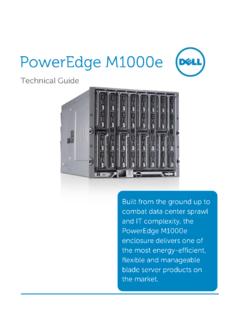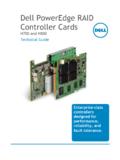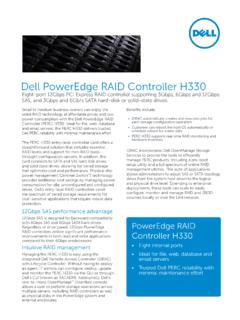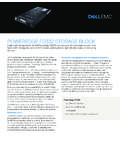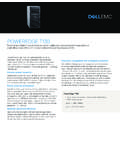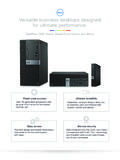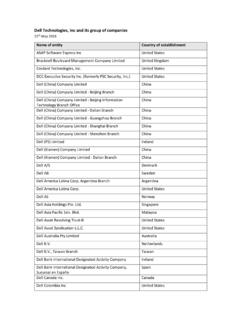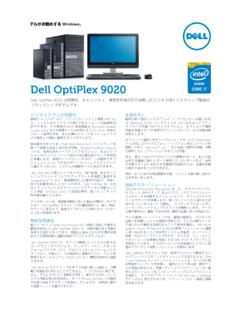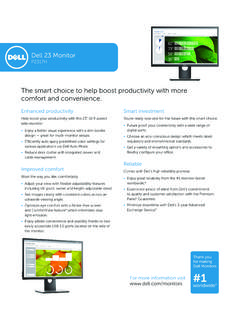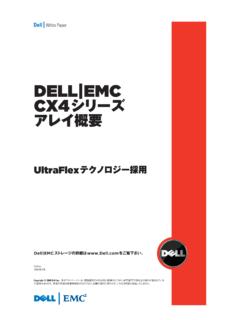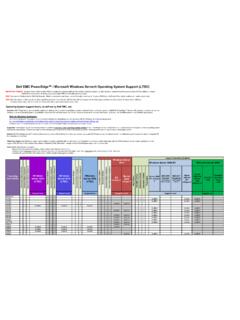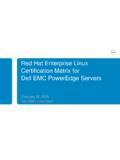Transcription of Dell PowerEdge T620 Technical Guide
1 PowerEdge T620 Technical Guide An enterprise-class, two-socket tower server with balanced high performance, high availability and built-in room for growth. ii PowerEdge R620 Technical Guide This document is for informational purposes only. Dell reserves the right to make changes without further notice to any products herein. The content provided is as is and without express or implied warranties of any kind. Dell, the DELL logo, PowerEdge , EqualLogic, PowerVault, OpenManage, KACE and ReadyRails are trademarks of Dell, Inc. Intel and Xeon are registered trademarks of Intel Corporation in the and other countries. Microsoft, Windows, Windows Server, SQL Server, BitLocker, ActiveX, Internet Explorer and Hyper-V are either registered trademarks or trademarks of Microsoft Corporation in the United States and/or other countries.
2 Novell and SUSE are registered trademarks of Novell, Inc. in the United States and other countries. IBM and Tivoli are registered trademarks of IBM in the United States. AMD and combinations thereof, are trademarks of Advanced Micro Devices, Inc. Other trademarks and trade names may be used in this document to refer to either the entities claiming the marks and names or their products. Dell disclaims proprietary interest in the marks and names of others. Copyright 2013 Dell Inc. All rights reserved. Reproduction or translation of any part of this work beyond that permitted by copyright laws without the written permission of Dell Inc. is unlawful and strictly forbidden. December 2013 | Version iii PowerEdge R620 Technical Guide Table of contents 1 System overview.
3 6 Introduction .. 6 Key technologies .. 7 2 System features .. 8 Comparison of PowerEdge systems .. 8 Specifications .. 9 3 Chassis views and features .. 12 Chassis views .. 12 Chassis features .. 15 4 Processor ..18 Processor features ..18 Supported processors .. 19 GPU support .. 20 Chipset .. 21 5 Memory .. 22 Supported memory .. 22 Memory configurations .. 23 Memory speed .. 23 Memory RAS 24 6 Storage .. 26 Internal storage .. 26 External storage .. 27 Storage controllers .. 28 Optical drive .. 29 Tape drive .. 30 7 Networking and PCIe .. 31 Embedded NIC controller .. 31 PCIe expansion .. 31 8 Power, thermal and acoustics .. 33 Power consumption and energy efficiency .. 33 Power supply units .. 34 Thermal and 35 9 Rack rails and cable management .. 38 Sliding rail system.
4 38 Cable management 39 10 Operating systems and virtualization .. 40 Supported operating systems .. 40 Supported virtualization ..41 11 Dell OpenManage systems management .. 42 Systems management solutions .. 42 OpenManage systems management .. 43 Dell server management operations .. 47 Appendix A. Additional specifications and options .. 50 Chassis dimensions .. 50 Chassis 50 Environmental specifications .. 51 Power supply specifications .. 52 Rack rail specifications .. 52 Video specifications .. 53 USB peripherals .. 53 iv PowerEdge R620 Technical Guide Appendix B. Standards compliance .. 54 Appendix C. Additional resources .. 56 Appendix D. System board block diagram .. 58 Tables Table 1. Key technologies .. 7 Table 2. Comparison of PowerEdge T610, T710 and T620.
5 8 Table 3. Technical specifications .. 9 Table 4. Chassis features .. 15 Table 5. Security features .. 17 Table 6. Supported processors .. 19 Table 7. GPU cards supported .. 20 Table 8. Memory technologies supported .. 22 Table 9. DIMMs supported .. 23 Table 10. Memory speed capabilities .. 24 Table 11. Memory RAS features .. 24 Table 12. Supported hard drives .. 26 Table 13. Supported external storage .. 27 Table 14. RAID controllers .. 28 Table 15. Hard-drive backplane options .. 29 Table 16. Tape devices supported .. 30 Table 17. Supported NICs and HBAs .. 31 Table 18. Additional supported PCIe expansion cards .. 32 Table 19. Power tools and technologies .. 33 Table 20. Power supply efficiency .. 35 Table 21. Acoustical performance .. 37 Table 22. T620 supported rack rail system.
6 39 Table 23. Primary operating system support .. 40 Table 24. Virtual guest operating system support ..41 Table 25. Virtualization support ..41 Table 26. iDRAC7 with Lifecycle Controller functions and benefits .. 43 Table 27. Feature comparison for iDRAC7 Express and Enterprise .. 44 Table 28. One-to-one and one-to-many operations .. 48 Table 29. Tower and rack chassis weight .. 50 Table 30. Environmental specifications .. 51 Table 31. Power supply specifications .. 52 Table 32. Rail adjustability range .. 52 Table 33. Supported video modes .. 53 Table 34. Industry standards documents .. 54 Table 35. Additional resources .. 56 Figures Figure 1. Front view without bezel .. 12 Figure 2. Front view with 13 Figure 3. Rackable front view without bezel .. 13 Figure 4. Back view.
7 14 Figure 5. Internal view ..14 Figure 6. Tower system with LCD panel .. 16 Figure 7. Rack system with VGA port .. 16 Figure 8. QRL code inside chassis cover .. 16 Figure 9. 750W power supply unit .. 35 Figure 10. Sliding rails with optional CMA .. 38 Figure 11. Dell systems management solutions .. 42 Figure 12. Systems management server lifecycle .. 48 v PowerEdge R620 Technical Guide Figure 13. Tower and rack chassis dimensions .. 50 Figure 14. T620 system board block diagram .. 58 6 PowerEdge T620 Technical Guide 1 System overview Introduction The Dell PowerEdge T620 is a feature-rich, two-socket tower server with up to 24 DIMM slots, storage capacity of up to 32 or 12 drive bays, and processing power from the Intel Xeon processor E5-2600 or E5-2600 v2 product families.
8 The T620 shines in its ability to handle demanding workloads with up to 16 processor cores, high memory density, and high I/O bandwidth. The T620 is an excellent platform for key applications such as business analytics and intelligence, information management, customer relationship management, security management, desktop virtualization, medical imaging, and graphical rendering. Designed for demanding small- and medium-sized business environments and enterprise data centers The extensive 768GB memory footprint, large local storage capacity, and I/O flexibility of the PowerEdge T620 make it an attractive platform for a wide range of applications and workloads, including server consolidation and virtualization. The T620 features allow you to achieve space savings, use your IT administrator s time more efficiently, and minimize potential software licensing fees.
9 The T620 is a flexible server with excellent energy efficiency and acoustical performance, allowing it to be placed into quiet office settings. The T620 can also be rack-mounted and is fully compatible with rack infrastructures. Businesses and organizations with remote offices need not worry, as the T620 offers consistent worldwide support. Safeguard your data and business Features that protect data and help keep your server running are essential. The T620 and its large storage capacity offer both software-based RAID and hardware RAID controller options to protect critical business information. Features that help to keep your business up and running include reliability, availability, and serviceability (RAS) options like hot-pluggable fans, disks, and power supplies, along with redundant, failsafe hypervisors that minimize the need to take a server away from productive work to replace parts.
10 Simplified systems management, without compromise The Dell OpenManage systems management portfolio includes Integrated Dell Remote Access Controller 7 (iDRAC7) with Lifecycle Controller. This embedded feature helps IT administrators manage Dell servers in physical, virtual, local and remote environments, operating in-band or out-of-band, with or without a systems management software agent installed. OpenManage iDRAC with Lifecycle Controller integrates and connects to leading third-party systems management solutions (such as those from Microsoft, VMware and BMC Software), so users can maintain a single point of control and capitalize on an existing systems management investment. OpenManage simplifies the lifecycle of deploying, updating, monitoring and maintaining Dell PowerEdge servers.
